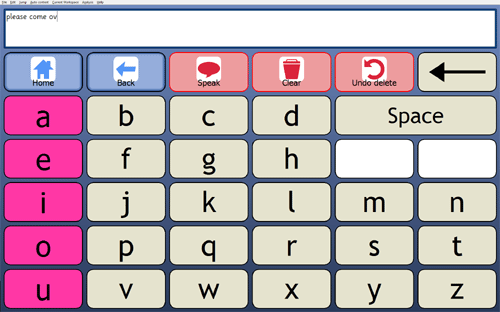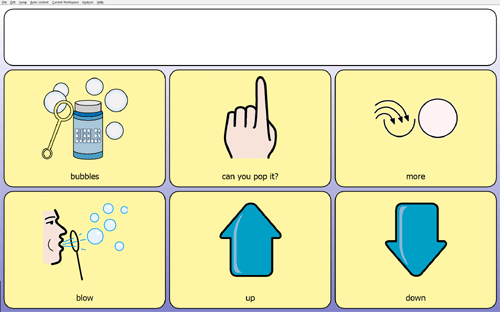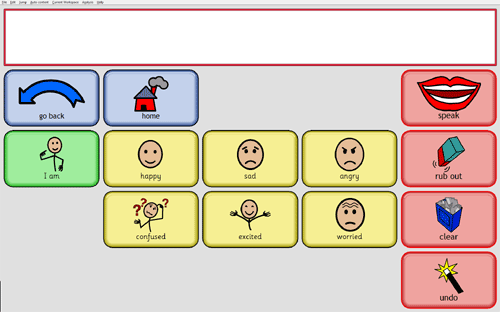Auditory scanning is a technique for presenting options using an audible prompt. The audible prompts are presented individually in sequence or in groups. A option is selected by an action, for example a vocalisation, head nod, eye blink, eyes up, or switch activation. Selections continue so that characters can be compiled to spell words, or words or symbols can be sequenced to make a message or any keyboard character or command can be selected for computer operation.
Who uses auditory scanning?
Auditory scanning is most commonly used by children and adults who have a physical disability combined with the need or preference for auditory input, for example where an individual has low vision, cortical vision impairment or other issues that affect ability to use a visual display. It also works as a system requiring minimal equipment for use in a variety of settings, for example when in the bath, or swimming pool. Auditory scanning can be combined with visual scanning, where a communication chart is used to display options in addition to the use of auditory prompts.
What equipment is needed?
No special equipment is needed to use partner assisted auditory scanning. A trained assistant can provide the auditory prompts or cues by reading or speaking them. The individual responds when hearing the required option, and so the process continues. This system relies on the assistant knowing how to implement the process and to interpret the responses. Familiar people can become very efficient with this system once the groupings are learned. The auditory cues may be minimised to “row 1, row 2, row 3 etc” and further to “1, 2, 3, etc” or "blue, red, green etc". This is called “partner assisted auditory scanning”.
A video on YouTube shows partner assisted auditory scanning using no aids.(watch video)
Assistive Technology
Assistive Technology can be used for auditory scanning systems for an individual, which may provide independence to write, formulate a message to communicate or for computer operation.
The use of technology may mean that the a trained partner is not required while the technology is in use. The individual in such a situation would most likely have a low tech system (partner assisted) and a high tech system.
Communication AAC
Spelling to communicate:
Using a Speech Generating Device with switch/scanning access the system can be set-up so that the operator hears prompts through the “public speaker” or a “private speaker” such as a headphone or pillow speaker. The auditory prompts may be linear initially , for example “A, B, C,D,E,F ….." or grouped, for example “A to F, G to K, M to R ….”
The operator’s response takes the form of activating a keyboard key, for example the SPACE BAR, or a remote switch, for example a head switch, foot switch, chin switch or any switch suited to the movement which is reliable, independent and non-fatiguing for the individual. Some devices permit the entire display to be used as a switch, so touching anywhere on the display will make the selection.
The grid set below shows an alphabetical array suitable for auditory scanning. It is similar to the lowe tech array used in the video noted above.

Symbol or whole words to communicate
When using symbols to formulate a message or to select a whole message the vocabulary needs to made available using auditory prompts.
To start, there may be just a few selections in a linear structure.
- The example below would provide the auditory prompts as key words: "bubbles", "pop", "more", "blow", 'up" and "down".
- When selected the message would speak out in full, for example "blow more bubbles"

To move to the next stage of auditory scanning using symbols, it is necessary to use categories/branching.
This permits a wider vocabulary, formulation of sentences and combination of phrases.
The page below coule be used for Auditory Scanning to combine a sentence starter "I am...." and an adjective (feeling).

Scanning pattern can be linear and later progress to row/column.
Row/column auditory scanning can offer more categories and vocabulary but is more demanding of working memory.
When the auditory prompts are less predictable the auditory scanning process may become complex.
At an entry level a small selection of options may be presented within an activity.
For example, to offer a drink the auditory prompts may be structured as follows:
Q: “Would you like a drink Sarah?”
A: Sarah indicates “yes”
Q: I’ll tell you what we have, then ask again so you can choose”
Lemonade, water, milk, juice, none of these.
Okay ready? Lemonade (pause) water (pause) milk (pause), juice, (pause) none of these (pause)
If a response is given, repeat the option and confirm.
“juice, is that it?”
A: yes
It is possible to set-up auditory scanning for communication using categories which branch to whole message or words. If whole messages are used, usually cue words can be set-up within the software.
Example of cue words:
Whole message = “I want bubbles”
Auditory prompt = bubbles
The home page or menu page would contain the categories, which have their own auditory prompts. These branch to pages of individual options or further categories.
There is a significant memory load when using this type of system.
Beyond entry level the user may learn to navigate the categories to find a whole message.
To progress to core vocabulary or combining words to make a message, a more complex set-up will be required. Again the memory load must be considered. The user will have something to say and must hold this in their working memory while navigating to find the words to make their message. As the message is formulated they must also keep track of their selections. If you have set up such a configuration, have someone try it who is not familiar with the structure. This may parallel what the user is being asked to do and any structural issues identified.
Computer control
Auditory scanning and switch/scanning can offer an access method for computer control.
If literacy and computer skills are limited it is still possible to provide computer control within an activity, for example Grid 3’s grid set for structuring an email,
The hardware and software must be compatible to offer auditory scanning.
